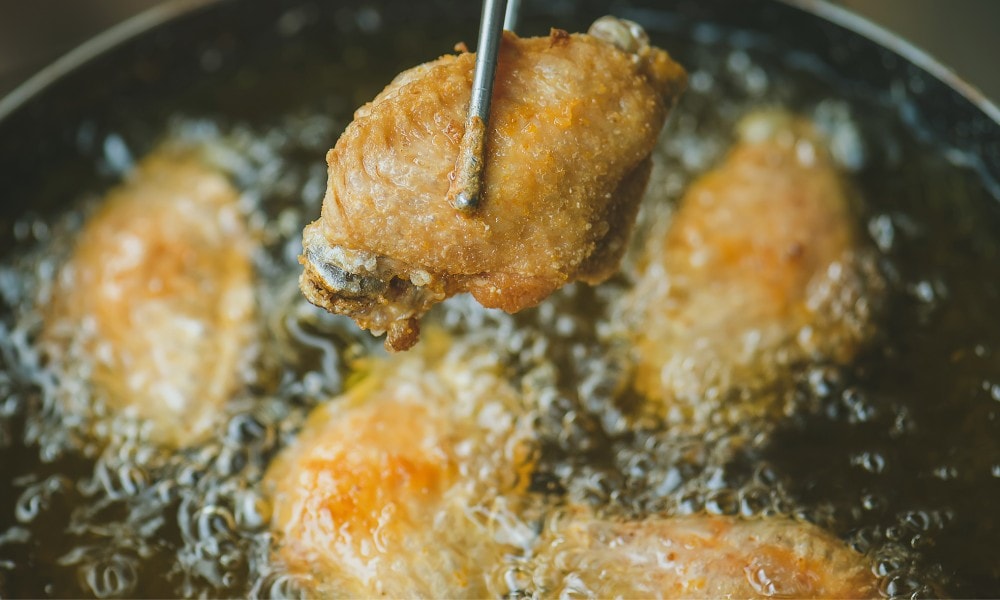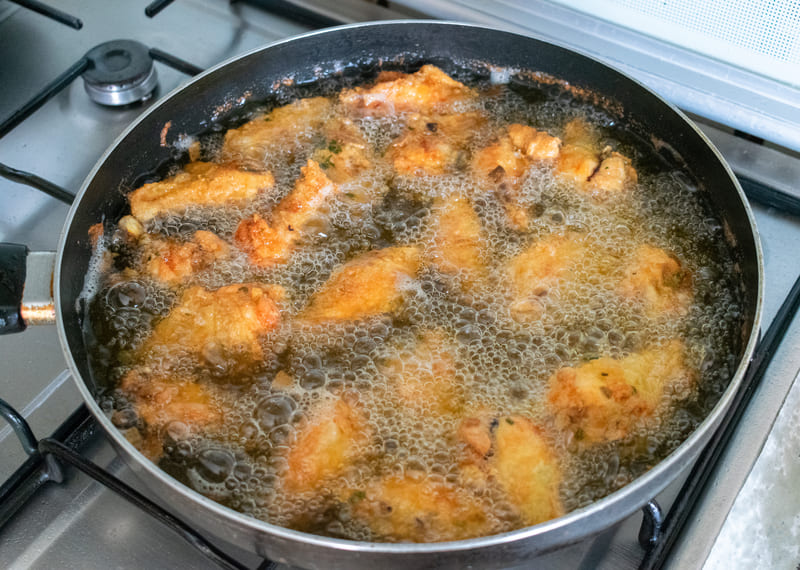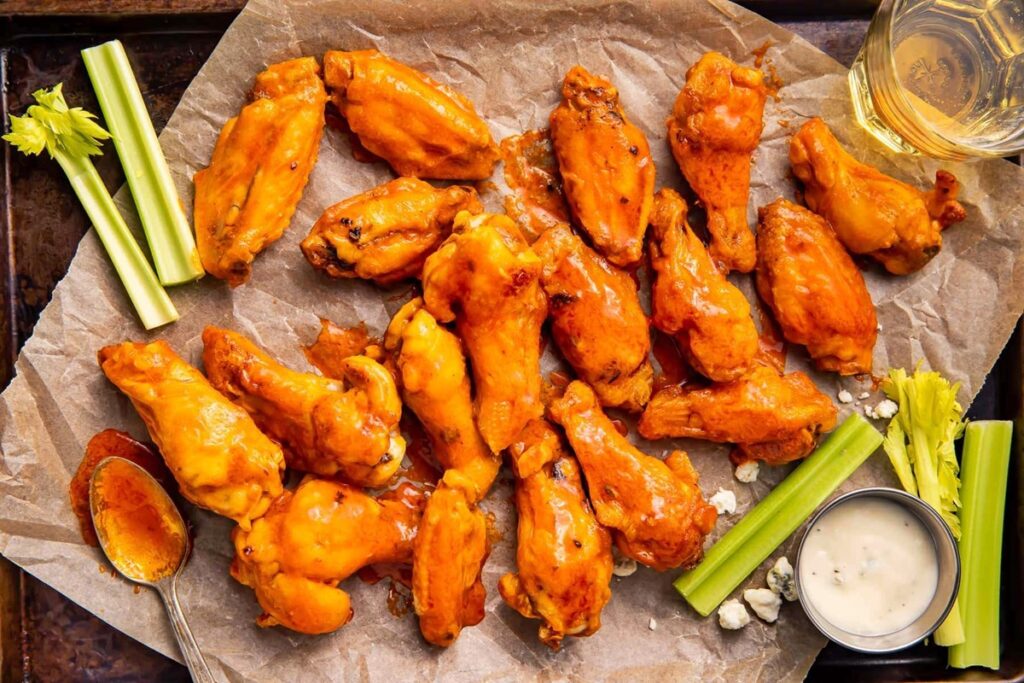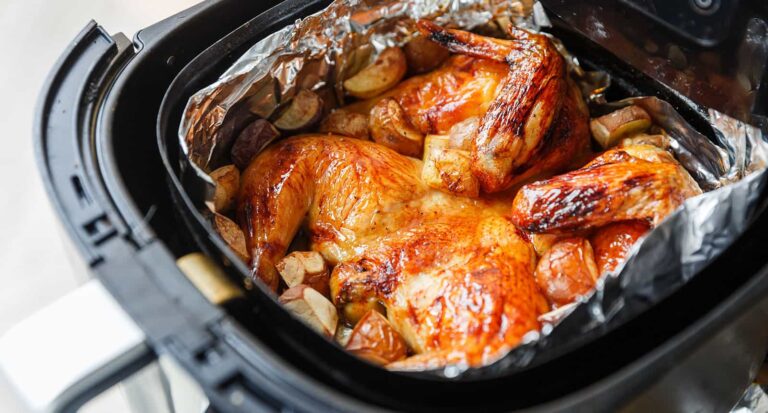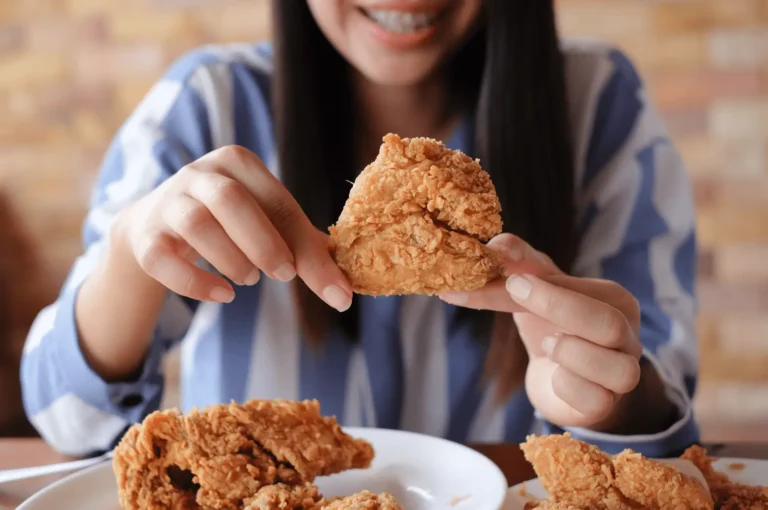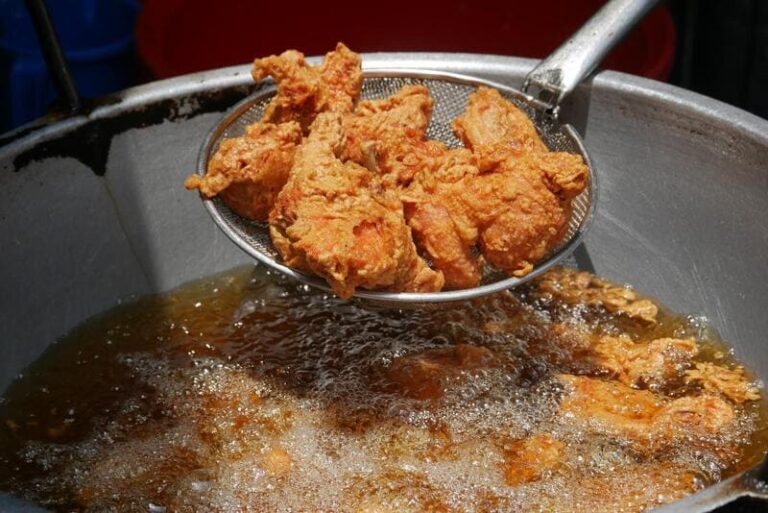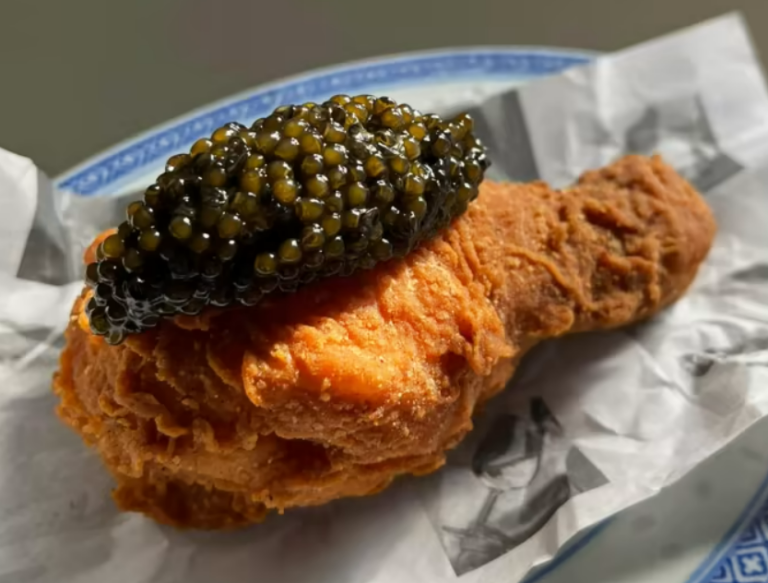Can You Deep Fry Frozen Chicken Wings ?
Imagine standing on the precipice of culinary exploration, gazing into the depths of your freezer like an intrepid adventurer.
There, nestled amongst the frosty unknowns, you spot a bag of frozen chicken wings. Can you transform these icy morsels into a crispy delight that will leave your taste buds in awe?
The answer lies within the realm of deep frying, a technique that promises to elevate these wings to new heights of flavor. But how exactly can you achieve this culinary feat?
Stay tuned, for the for guide to Can You Deep Fry Frozen Chicken Wings.
Contents
- 1 Key Takeaways
- 2 Safety Precautions
- 3 Necessary Equipment
- 4 Proper Thawing Methods
- 5 Preparing the Chicken Wings
- 6 Choosing the Right Oil
- 7 Temperature and Cooking Time
- 8 Tips for Crispy Wings
- 9 Avoiding Oil Splatter
- 10 Serving and Enjoying Your Wings
- 11 Frequently Asked Questions
- 11.1 Can I Use a Different Type of Oil for Deep Frying Frozen Chicken Wings?
- 11.2 How Can I Prevent the Chicken Wings From Sticking to the Frying Basket?
- 11.3 Can I Reuse the Oil After Deep Frying the Chicken Wings?
- 11.4 What Are Some Alternative Cooking Methods for Frozen Chicken Wings?
- 11.5 Can I Add Any Seasonings or Marinades to the Chicken Wings Before Deep Frying Them?
- 12 Conclusion – Can You Deep Fry Frozen Chicken Wings
Key Takeaways
- Thawing the chicken wings properly is important for safe cooking.
- Safety precautions such as having a fire extinguisher and first aid kit nearby should be followed.
- Choosing the right oil with a high smoke point is essential for deep frying.
- Never leave the deep fryer unattended to prevent fire hazards.
Safety Precautions
To ensure your safety while deep frying frozen chicken wings, it’s important to follow these essential precautions.
First and foremost, always have a first aid kit nearby in case of any accidents. Accidental burns can happen, so make sure to keep burn ointment and bandages readily available.
Additionally, it’s crucial to prioritize ventilation in your cooking area. Deep frying can produce a significant amount of smoke and oil fumes, which can be harmful if inhaled in large quantities. Open windows or use exhaust fans to ensure proper airflow and minimize the risk of respiratory issues.
Furthermore, never leave the deep fryer unattended while it’s in use. Hot oil poses a fire hazard, and a momentary distraction could lead to disastrous consequences. Always stay vigilant and keep a fire extinguisher nearby, just in case.
It’s also essential to thaw your frozen chicken wings completely before deep frying them. Partially frozen wings can cause dangerous splattering of hot oil, increasing the risk of burns.
Necessary Equipment
Ensure you have the necessary equipment before deep frying your frozen chicken wings. Having the right tools and ingredients will help you achieve the best results and make your cooking experience hassle-free.
First and foremost, you’ll need a deep fryer or a large, heavy-bottomed pot to hold the oil. A deep fryer is recommended as it provides precise temperature control, but a pot will work just fine if you have a thermometer to monitor the oil temperature. Make sure the fryer or pot is large enough to accommodate the wings without overcrowding.
Next, you’ll need a pair of tongs or a slotted spoon to safely handle the wings while frying and removing them from the oil. This will prevent any accidents or burns.
In terms of ingredients, you’ll need cooking oil with a high smoke point, such as vegetable or peanut oil. These oils can withstand the high temperatures required for deep frying without burning.
That’s it! With a deep fryer or large pot, tongs or a slotted spoon, and the right oil, you’re ready to start deep frying your frozen chicken wings.
Enjoy experimenting with different cooking methods and alternative ingredients to create deliciously crispy wings at home.
Proper Thawing Methods
To ensure safe thawing of frozen chicken wings, there are a few techniques you can follow.
One method is to thaw the wings in the refrigerator, allowing them to defrost slowly and evenly.
Alternatively, you can use the cold water thawing method, submerging the wings in a sealed bag in cold water, while changing the water every 30 minutes.
It’s important to note that thawing time can vary depending on the size of the wings, so it’s recommended to refer to the packaging or consult a reliable source for specific guidelines.
Safe Thawing Techniques
For safe thawing of frozen chicken wings, it’s recommended to use proper thawing methods to ensure optimal results. Here are some defrosting guidelines and alternative thawing methods you can try:
-
Refrigerator thawing: Place the frozen chicken wings in a container and let them thaw in the refrigerator overnight. This method allows for slow and even thawing, reducing the risk of bacterial growth.
-
Cold water thawing: If you’re short on time, you can thaw the chicken wings by placing them in a sealed plastic bag and submerging them in cold water. Change the water every 30 minutes to maintain a safe temperature.
-
Microwave thawing: Use the defrost setting on your microwave to thaw the chicken wings. Be sure to follow the manufacturer’s instructions and rotate the wings regularly to ensure even thawing.
-
Cook from frozen: If you’re in a hurry, you can skip the thawing process altogether and cook the frozen chicken wings directly. Just make sure to adjust the cooking time accordingly.
Thawing Time Recommendations
To achieve optimal results when thawing frozen chicken wings, it’s important to follow proper thawing methods and consider the recommended thawing times. Thawing chicken wings at room temperature isn’t recommended as it can lead to bacterial growth.
The quickest way to thaw frozen chicken wings is by using the cold water method. Simply place the wings in a leak-proof plastic bag and submerge them in cold water. Change the water every 30 minutes until the wings are thawed completely. This method usually takes about 2-3 hours.
Alternatively, you can use the defrost setting on your microwave, following the manufacturer’s instructions. However, be cautious as microwaving may partially cook the wings, affecting their texture when deep frying.
Preparing the Chicken Wings
Start by carefully thawing the frozen chicken wings in the refrigerator overnight. Thawing the wings in the refrigerator ensures a safe and even thawing process, preserving the quality and taste of the meat.
Once the wings are fully thawed, it’s time to prepare them for deep frying. Here are four steps to get your chicken wings ready for a flavorful fry:
-
Preparing the Marinade: To infuse your chicken wings with delicious flavor, consider marinating them. You can use a pre-made marinade or create your own using ingredients like garlic, soy sauce, honey, and spices. Simply place the thawed wings in a bowl, pour the marinade over them, and let them sit for a couple of hours or overnight in the refrigerator.
-
Drying the Wings: Before frying, it’s crucial to pat the wings dry with paper towels. This step ensures that excess moisture is removed, allowing the wings to achieve that crispy texture we all love.
-
Seasoning the Wings: To add an extra kick of flavor, season the wings with salt, pepper, and any other desired spices. This step will elevate the taste and make your wings truly irresistible.
-
Exploring Alternative Cooking Methods: While deep frying is a popular choice, you can also explore alternative cooking methods such as baking or grilling. These methods offer a healthier option while still delivering deliciously crispy wings.
Choosing the Right Oil
When choosing the right oil for deep frying frozen chicken wings, it’s important to consider factors such as smoke point and flavor. Smoke point refers to the temperature at which the oil begins to break down and produce smoke. You want an oil with a high smoke point to ensure that it can withstand the high heat required for deep frying without turning rancid or producing harmful fumes. Some oils with high smoke points include canola oil, peanut oil, and sunflower oil. These oils also have a neutral flavor, allowing the taste of the chicken wings to shine through.
If you’re looking to choose healthy oils, you can experiment with different options. Olive oil, for example, has a lower smoke point but can still be used for frying at lower temperatures. It adds a distinct flavor to the wings, which some people enjoy. Avocado oil and coconut oil are other healthy alternatives that can withstand high heat and provide a unique taste to your chicken wings. It’s all about finding the right balance between health and flavor.
Ultimately, it’s up to you to decide which oil suits your taste preferences and dietary needs. Don’t be afraid to try different oils and see which one works best for your deep-fried frozen chicken wings. Enjoy the freedom to experiment and create your own delicious combinations!
Temperature and Cooking Time
Ensure that the temperature of your oil is at the correct level and that you cook your frozen chicken wings for the appropriate amount of time to achieve crispy, golden results. Here are four essential tips to help you master the cooking techniques and create delicious flavor variations:
-
Temperature control:
Maintaining the right oil temperature is key to achieving perfectly cooked chicken wings. Heat your oil to around 375°F (190°C) to ensure a crispy exterior while keeping the meat tender and juicy on the inside. -
Cooking time:
The cooking time for frozen chicken wings will vary depending on their size and thickness. Typically, it takes about 10 to 12 minutes to deep fry small to medium-sized wings. Larger wings may require a few extra minutes. Always check the internal temperature with a meat thermometer to ensure they reach a safe minimum internal temperature of 165°F (74°C). -
Batches and overcrowding:
To ensure even cooking, avoid overcrowding the fryer or pan. Fry the wings in small batches, allowing enough space for them to float freely and cook evenly. -
Flavor variations:
Experiment with different seasonings and sauces to add variety to your chicken wings. From classic buffalo sauce to tangy BBQ or spicy Asian-inspired glazes, the possibilities are endless. Toss the cooked wings in your chosen sauce or serve it on the side for dipping.
Tips for Crispy Wings
To achieve crispy wings, it’s important to follow these tips for optimal frying results.
Firstly, make sure to season your wings before frying. This step is crucial for enhancing the flavor of your wings. You can use a variety of seasonings such as salt, pepper, garlic powder, paprika, or even cayenne pepper for some heat. Experiment with different combinations to find your perfect flavor profile.
Next, ensure that your wings are completely dry before frying. Excess moisture can lead to less crispy results. Pat them dry with paper towels or let them air dry for a while.
When it comes to frying, oil temperature is crucial. Heat your oil to around 375 degrees Fahrenheit for the best results. This high temperature will help to create that crispy exterior while keeping the meat juicy and tender on the inside.
Lastly, avoid overcrowding the fryer. Frying too many wings at once can lower the oil temperature and result in soggy wings. Fry in small batches to maintain the optimal temperature and achieve that desired crispiness.
Avoiding Oil Splatter
To prevent oil splatter while deep frying wings, you can take a few precautions. Here are four tips to help you avoid burns and reduce mess while enjoying your crispy chicken wings:
-
Use a deep fryer with a lid: A deep fryer with a lid can help contain the oil and prevent it from splattering all over your kitchen. Make sure to keep the lid on while frying and only remove it when necessary.
-
Pat the wings dry: Before adding the wings to the hot oil, make sure to pat them dry with paper towels. Excess moisture on the wings can cause oil splatter, so removing as much moisture as possible will help reduce the risk.
-
Fry in small batches: Overcrowding the fryer can cause the oil to bubble and splatter. To prevent this, fry the wings in small batches, allowing enough space for the oil to circulate around each piece.
-
Use a splatter screen: Another option to reduce oil splatter is to use a splatter screen. This screen acts as a barrier between the oil and your stovetop, preventing the oil from reaching high temperatures and splattering all over the place.
Serving and Enjoying Your Wings
Now that you have successfully avoided oil splatter while deep frying your wings, it’s time to move on to serving and enjoying your crispy chicken wings. After all, what’s the point of making delicious wings if you can’t enjoy them to the fullest?
To elevate the flavor of your wings, consider adding some flavorful sauce options. Whether you prefer tangy BBQ sauce, spicy buffalo sauce, or a zesty garlic parmesan sauce, there are endless possibilities to suit your taste buds. You can even experiment with different combinations or create your own signature sauce. Just toss your wings in the sauce of your choice or serve it on the side for dipping.
To complete your wing experience, pair them with the best side dishes. Classic options like celery sticks and carrot sticks with ranch or blue cheese dressing are always a hit. For something heartier, try serving your wings with a side of coleslaw, potato wedges, or mac and cheese. These sides not only complement the flavors of the wings but also add variety to your meal.
Now that you know how to serve and enjoy your wings, gather your friends, grab some cold drinks, and savor the deliciousness of your homemade crispy chicken wings. Enjoy the freedom of indulging in your favorite flavors!
Frequently Asked Questions
Can I Use a Different Type of Oil for Deep Frying Frozen Chicken Wings?
You can use different oils for deep frying frozen chicken wings. Each oil has its own benefits, such as higher smoke points or healthier options. Experiment with oils like vegetable, canola, or peanut to find your favorite. Enjoy the freedom to choose!
How Can I Prevent the Chicken Wings From Sticking to the Frying Basket?
To prevent your chicken wings from sticking to the frying basket, make sure it’s properly greased before adding the wings. Also, try not to overcrowd the basket and maintain the best frying temperature for crispy results.
Can I Reuse the Oil After Deep Frying the Chicken Wings?
Yes, you can reuse the oil after deep frying the chicken wings. Just strain it to remove any food particles and store it in a cool, dark place. When it’s time to dispose of the oil, never pour it down the drain.
What Are Some Alternative Cooking Methods for Frozen Chicken Wings?
If you’re wondering about alternative cooking methods for frozen chicken wings, you could try air frying or baking for a healthier option. If you’re after flavor, grilling or broiling might be your best bet. The choice is yours!
Can I Add Any Seasonings or Marinades to the Chicken Wings Before Deep Frying Them?
Yes, you can add flavor to frozen chicken wings before deep frying them. Simply marinate them or sprinkle seasonings on them. Remember to adjust the cooking time accordingly for the added ingredients.
Conclusion – Can You Deep Fry Frozen Chicken Wings
So, Can You Deep Fry Frozen Chicken Wings? Absolutely! Just remember to follow the necessary safety precautions, properly thaw the wings, and use the right equipment and oil.
Keep an eye on the temperature and cooking time, and use the tips provided to achieve crispy wings. And don’t forget to avoid oil splatter!
Once cooked, serve and enjoy your delicious wings. Now you can satisfy your craving without any hassle.
Bon appétit!
